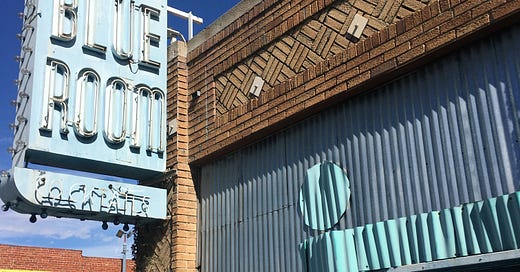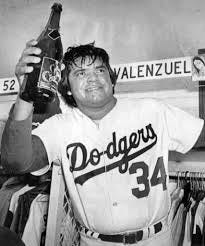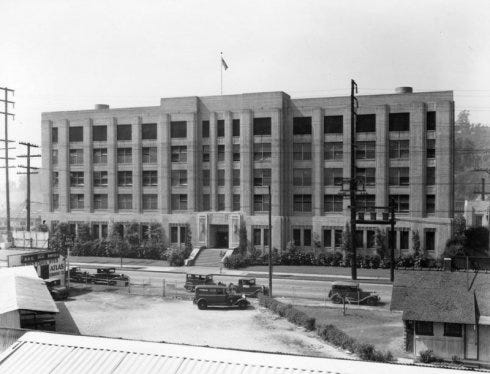In September of 1797 the seventeenth Spanish mission of Alta California was founded, named for Saint Ferdinand. Mission San Fernando Rey de España would become the namesake of a road, city, and a valley so famous it is often referred to as the Valley. The road in question runs 24 miles from Castaic to downtown Los Angeles—this issue of Take Surface Streets concerns the last several miles which primarily consist of river-hugging industrial plots until disappearing into downtown Burbank, bookended by two storied L.A. buildings that have long sat dormant.
Beginning in Lincoln Heights, San Fernando Road emerges from Avenue 20 (at Pasadena Avenue) heading northwest, running parallel to the Los Angeles River and the train tracks stemming from the rail yards downtown.
The first major landmark you’ll notice is the abandoned Lincoln Heights Jail, on the street beside San Fernando, Avenue 19. Visible from the route and even better from the Gold Line, the building is a derelict Art Deco giant. With broken windows and boarded entrances, the apparently haunted building, opened in 1931, is now officially used for film and music video shoots, unofficially for squatting and tagging.
At the time of its opening, the jail had a capacity of 625 prisoners. 15 years later, the same space routinely held up to 2,800 prisoners, beginning a long tradition of inmate overcrowding in California. The jail briefly held Al Capone for a night, as well as many involved in the Zoot Suit and Watts riots. It also created a wing for gay inmates due to an extremely high number of prisoners persecuted for their sexual orientation.
On Christmas Eve, 1951, two parties were about to meet in violent storm. A group of Chicano men were celebrating the holiday at a bar on Riverside Drive near Griffith Park when two of LAPD’s finest entered and attempted to quell the revelry. A fight erupted and the outnumbered cops were jumped by a group of patrons. They escaped with minor injuries.
Hours later, cops rousted seven of the patrons from their homes and took most of them to Central Station—where the LAPD was having a Christmas party of their own. A wildly exaggerated rumor went around that one of the attacked officers was injured so badly he would lose an eye. This, and plenty of liquor, spurred the officers present at the party to remove the men from their cells and beat them for 90 minutes. The jail floor was painted with blood. They then moved the men to Lincoln Heights Jail and issued a second, brutal beating.
The press called it “Bloody Christmas” and it would be the first time a grand jury indicted serving LAPD officers, as well as the first ever convictions for police brutality in Los Angeles—an occurrence still rare today. It would also provide the basis for James Ellroy’s L.A. Confidential, as well as Curtis Hanson’s film of the same name.
Not only did the incident become the backbone of those fictionalizations, parts of the film were shot at Lincoln Heights Jail. A keen eye may also recognize its roof in American History X, or its interiors in music videos like Blink-182’s “Feeling This” or Lady Gaga and Beyonce’s “Telephone.”
As you drive north, cutting through corners of the Cypress and Glassell Park neighborhoods, there aren’t many interesting landmarks. There’s the tow lot the city takes your vehicle when they impound it, of which I have visited many times, and the mega-Goodwill known locally as “the bins.” As you enter the south side of Glendale you’ll come across such spectacular locations as the Color Me Mine International Headquarters. You’ll pass Dinah’s Chicken, a family-owned, inexpensive, delicious neighborhood favorite.
The road cuts industrial again, with textile and upholstery shops, a few dozen fabricators, from plumbing fixtures to plastics and signage to auto parts, all of which look like the perfect location to unload 1.6 million dollars in stolen bearer bonds, restaurant supply wholesalers, a gentleman’s club, a brewery, and Los Angeles’ premiere birthday-hosting skating rink. The International College of Beauty Arts and Sciences will definitely catch your eye (and is still in operation, Frenchy.)
And then you’ll come across one of Los Angeles’ first airports: the Grand Central Air Terminal.
Built in 1928, the airstrip was inspired by Leslie Brand’s own private strip just below Brand Castle (where Brand Park and Brand Library sit today). Brand had his own grass runway built and held regular “plane parties”—guests were asked to transport themselves with their own aircraft. This spurred local investors to create a strip for commercial use.
On July 8th, 1929, Charles Lindbergh piloted the first leg of the first flight of the “City of Los Angeles,” a tri-motor Ford airplane which inaugurated Transcontinental Air Transport, the passenger and air mail service which would later become TWA. These trips were a hybrid of air and rail travel. The planes would land at dusk and transfer the passengers to trains, which would continue on until morning, picking up at the next air field and taking off again. For its debut, Mary Pickford christened the craft with a bottle of grape juice. Prohibition prevented the use of champagne.
Titans of the aerospace industry had humble beginnings at Grand Central. Howard Hughes, while filming Hell’s Angeles, built the H-1 Racer there with Glenn Odenkirk, his silver bullet with the flushed rivets you might remember from The Aviator. Jack Northrop began his company Avion Aviation there and then sold it to William Boeing, who moved the business to what is now the Hollywood-Burbank Airport.
The aircraft of the 1950s outgrew Grand Central’s minute size and the area’s hub of aviation defaulted to Burbank. The terminal and surrounding acreage is now a massive creative campus owned by The Walt Disney Company; the terminal itself housing the headquarters for The Disney Store.
To close out, if you’re in the area, may I suggest you grab a Key Lime Martini at The Blue Room?
99% of the time, I’m a beer and shot man, but I feel it’s necessary to always try the drink the bar is ~known for~ when you visit for the first time. I was so pleasantly surprised by their (cheap!) Key Lime Martini that I get at least one every time I stop by, and urge anyone with me to do the same. That, tripled with their magnetic neon sign and free jazz nights make The Blue Room worth a trip alone—but if you happen to be a movie location nerd, you may also recognize it as the bar that Carrie Anne Moss spits in Guy Pearce’s beer to see if he really has amnesia in Memento, or where De Niro calls Jon Voight toward the end of Michael Mann’s Heat.
Thanks for riding a long!
And your Weekly Dose of DWP (technically GWP):











